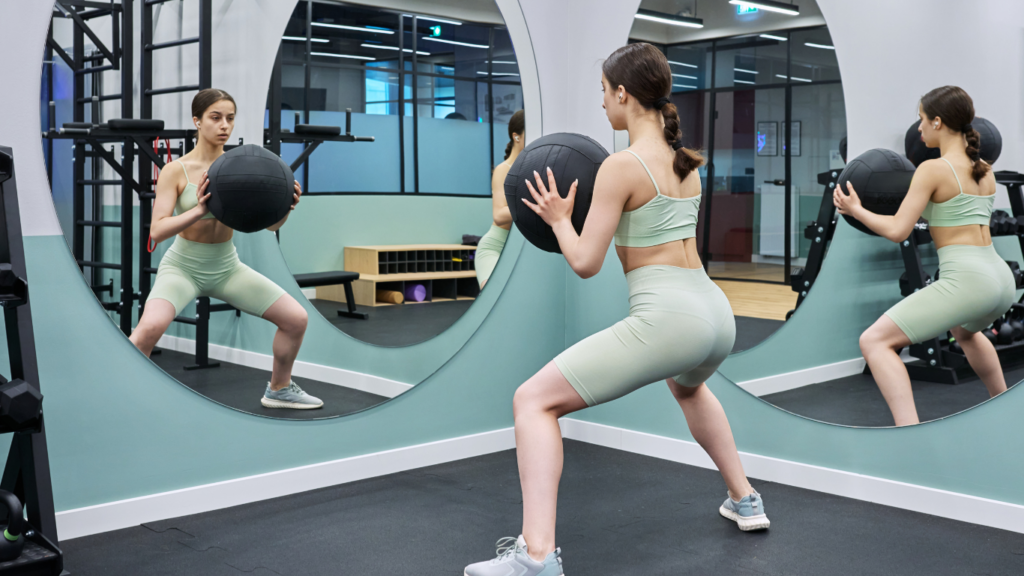Benefits of a Full-Body Workout Routine
A full-body workout routine offers numerous advantages that enhance overall fitness and health. First, time efficiency makes these routines appealing. By targeting multiple muscle groups simultaneously, I maximize the effectiveness of my workout sessions, spending less time while achieving more significant results.
Next, improved muscle balance is crucial for preventing muscle imbalances. Engaging various muscle groups ensures that no single area is overworked or neglected. This balance contributes to improved posture and reduced injury risk.
Enhanced calorie burning becomes possible through compound exercises like squats or push-ups that increase heart rate and boost metabolism. This heightened caloric expenditure aids in weight management and contributes to a leaner physique.
Increased strength is a natural byproduct of full-body routines. By incorporating exercises that require stabilizing muscles, I build functional strength that benefits daily activities. This approach is particularly valuable for those seeking practical, real-world strength enhancements.
Finally, flexibility and adaptability allow me to adjust routines according to my fitness goals and current abilities. Whether I’m a beginner or an advanced exerciser, I tailor my workouts to meet my evolving needs, maintaining interest and motivation over time.
Key Components of a Full-Body Workout
Developing a full-body workout routine at home involves focusing on several key components. Each component plays a crucial role in enhancing strength, endurance, and overall fitness.
Strength Training
Strength training forms the foundation of a full-body workout. It involves exercises targeting major muscle groups using bodyweight, resistance bands, or household items. Squats work the legs and core. Push-ups engage the chest, shoulders, and arms. Planks strengthen the core and stabilizing muscles. Consistently incorporating these exercises enhances muscle strength and endurance.
Cardio Elements
Cardio elements boost heart rate and improve cardiovascular health. Jumping jacks, high knees, and burpees increase heart rate and burn calories. Skipping rope offers an effective cardio workout in limited space. Performing these exercises at varying intensities promotes heart health and increases stamina, adding vital balance to your routine.
Flexibility and Mobility
Flexibility and mobility are essential for preventing injuries and improving movement efficiency. Dynamic stretches, like leg swings and torso twists, prepare muscles for workouts. Incorporating static stretches post-workout enhances muscle recovery and flexibility. Regular attention to these elements ensures a balanced and comprehensive workout routine.
Essential Equipment for Home Workouts
Creating a full-body workout routine at home often requires minimal equipment. While many exercises rely on bodyweight, a few essential items can enhance variety and effectiveness.
Bodyweight Exercises:
Bodyweight exercises are integral to home workouts. Using one’s body weight, exercises like:
- push-ups
- squats
- lunges
target major muscle groups without additional tools. These exercises improve strength and endurance, making them versatile and effective.
Minimal Equipment Options
Incorporating minimal equipment can diversify home workouts. Resistance bands offer portable resistance training and can adjust the intensity for various exercises. Dumbbells provide weight for strength training, aiding in muscle building. A yoga mat ensures comfort and safety during floor exercises. Together, these tools enhance the quality of home workouts while still keeping the setup simple and efficient.
Structuring Your Home Workout Routine
Creating a structured home workout involves intentional planning, ensuring each session is effective and balanced. By focusing on different aspects of the routine, I can maximize benefits and stay motivated.
Warm-up and Cool Down
Engaging in a proper warm-up prepares my body for exercise by increasing blood flow and reducing the risk of injury. A five-minute session with jumping jacks or high knees can effectively elevate my heart rate. Post-workout, a cool-down with static stretches like hamstring and triceps stretches aids recovery and muscle relaxation.
Balancing Exercise Types
A well-rounded routine balances strength, cardio, and flexibility exercises. On some days, focusing on push-ups, planks, and squats ensures my strength training targets major muscles. On cardio days, jumping rope or performing burpees boosts my cardiovascular endurance. Yoga or Pilates sessions improve both my flexibility and core strength.
Setting Weekly Goals
Setting clear weekly goals helps maintain motivation and track progress. I set specific targets, like completing five sessions, increasing push-up reps, or improving my yoga flexibility. Monitoring achievements keeps me accountable and highlights areas for further improvement, ensuring continuous development in my fitness journey.
Sample Full-Body Workout Plan

A well-structured at-home workout plan caters to various fitness levels. Here’s a full-body workout plan divided into beginner, intermediate, and advanced routines.
Beginner Routine
Starting out involves exercises that build foundational strength. Each day targets major muscle groups using bodyweight movements.
- Push-ups (3 sets of 8 reps): Engage chest, shoulders, and triceps.
- Bodyweight squats (3 sets of 10 reps): Focus on quads, hamstrings, and glutes.
- Planks (3 sets of 30 seconds): Strengthen core muscles.
- Lunges (3 sets of 10 reps per leg): Target lower body stability.
- Jumping jacks (3 sets of 15 reps): Add cardiovascular engagement.
Intermediate Routine
Progress to this routine by increasing intensity and incorporating minimal equipment.
- Incline push-ups (3 sets of 10 reps): Use a sturdy surface to intensify the push-up challenge.
- Dumbbell squats (3 sets of 12 reps): Introduce added weight for enhanced leg strength.
- Side planks (3 sets of 30 seconds per side): Target obliques and core stability.
- Reverse lunges (3 sets of 12 reps per leg): Enhance balance and leg endurance.
- High knees (3 sets of 20 reps): Boost cardio and leg endurance.
Advanced Routine
Elevate the workout with more complex movements and increased resistance.
- Decline push-ups (3 sets of 12 reps): Increase push-up resistance with elevated feet.
- Dumbbell deadlifts (3 sets of 15 reps): Target hamstrings and lower back.
- Russian twists (3 sets of 15 reps per side): Intensify core engagement.
- Bulgarian split squats (3 sets of 15 reps per leg): Improve single-leg strength and stability.
- Burpees (3 sets of 15 reps): Incorporate full-body cardio movement.
Each routine is scalable, allowing for adjustments based on personal progress and goals.
Tips for Staying Motivated and Consistent
Staying motivated and consistent is crucial for achieving fitness goals at home. By implementing practical strategies and maintaining a positive mindset, anyone can keep their routine on track.
Tracking Progress
Consistently monitoring progress keeps motivation high and helps refine workouts. I use a fitness journal to log exercises, sets, and reps, which allows me to see improvements over time. Digital tools like fitness apps offer another way to track stats like calories burned and workout duration, providing visual data for accomplishments. Regular evaluations, once a week or after a specific workout cycle, help identify areas needing adjustment, ensuring continuous progression.
Creating a Workout Space
A dedicated workout space enhances focus and commitment to a routine. I choose an area in my home with adequate room for movement and minimal distractions, ensuring safety and ease of access. Essential items such as a yoga mat, resistance bands, and light dumbbells fit neatly in small spaces. Personalizing the area with motivating elements like a vision board or inspirational quotes boosts enthusiasm and helps maintain a consistent exercise schedule.



 Senior Sports Writer
Alfred Alder is the senior sports writer at Sprint Scoop News, bringing his extensive knowledge of fitness, training, and sports business to the forefront. With a career spanning more than a decade, Alfred specializes in delivering high-quality, engaging content that covers everything from sponsorship trends to the latest in health and nutrition for athletes. His deep understanding of the sports industry allows him to provide readers with comprehensive insights that make complex topics accessible and exciting.
Senior Sports Writer
Alfred Alder is the senior sports writer at Sprint Scoop News, bringing his extensive knowledge of fitness, training, and sports business to the forefront. With a career spanning more than a decade, Alfred specializes in delivering high-quality, engaging content that covers everything from sponsorship trends to the latest in health and nutrition for athletes. His deep understanding of the sports industry allows him to provide readers with comprehensive insights that make complex topics accessible and exciting.
